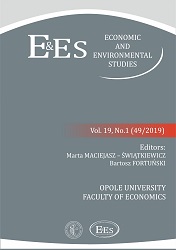The Use of Selected Methods of Linear Ordering to Assess the Innovation Performance of the European Union Member States
The Use of Selected Methods of Linear Ordering to Assess the Innovation Performance of the European Union Member States
Author(s): Elżbieta Roszko-Wójtowicz, Maria Magdalena GrzelakSubject(s): Supranational / Global Economy, Methodology and research technology, Economic development
Published by: Uniwersytet Opolski
Keywords: innovation measurement; linear ordering; Hellwig method; TOPSIS method; GDM method; normalisation of variables;
Summary/Abstract: The growing interest in measuring economic and social phenomena that are difficult to observe directly increases the need for researchers to broaden the use of multivariate statistical analysis methods. The ease of interpreting results presented in the form of rankings makes it common practice to use different methods of linear ordering of objects. If the appropriate assumptions are met, the determined set of variables allows for the construction of a synthetic measure whose ordered values provide a ranking. Such a statistical approach is quite often used in assessing the level of innovativeness of economies, and the literature abounds in various innovation indices. The starting point of this paper is a set of 27 variables on the basis of which the Summary Innovation Index is developed. After verifying the statistical assumptions and reducing the database to 21 diagnostic factors, the authors construct a total of nine innovation rankings, using different methods of linear ordering and selected procedures for normalisation of variables. The aim of the paper is therefore to assess the impact of selected methods of linear ordering (Hellwig’s method, TOPSIS method, GDM method) and various procedures for normalising variables (classic standardisation, positional standardisation, quotient transformation) on the final ranking of the EU Member States due to the level of their innovation performance. The obtained results confirm that the applied method of linear ordering and the selection of the normalisation procedure have an impact on the final ranking of the examined objects – in this case, the final ranking of the EU Member States due to the level of their innovativeness analysed in the presented research.
Journal: Economic and Environmental Studies
- Issue Year: 19/2019
- Issue No: 1 (49)
- Page Range: 9-30
- Page Count: 22
- Language: English

